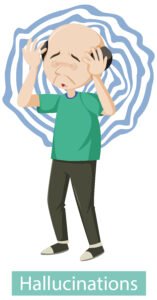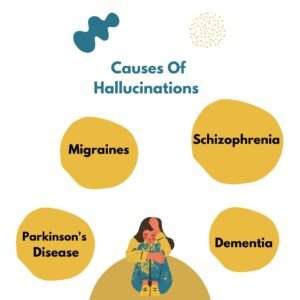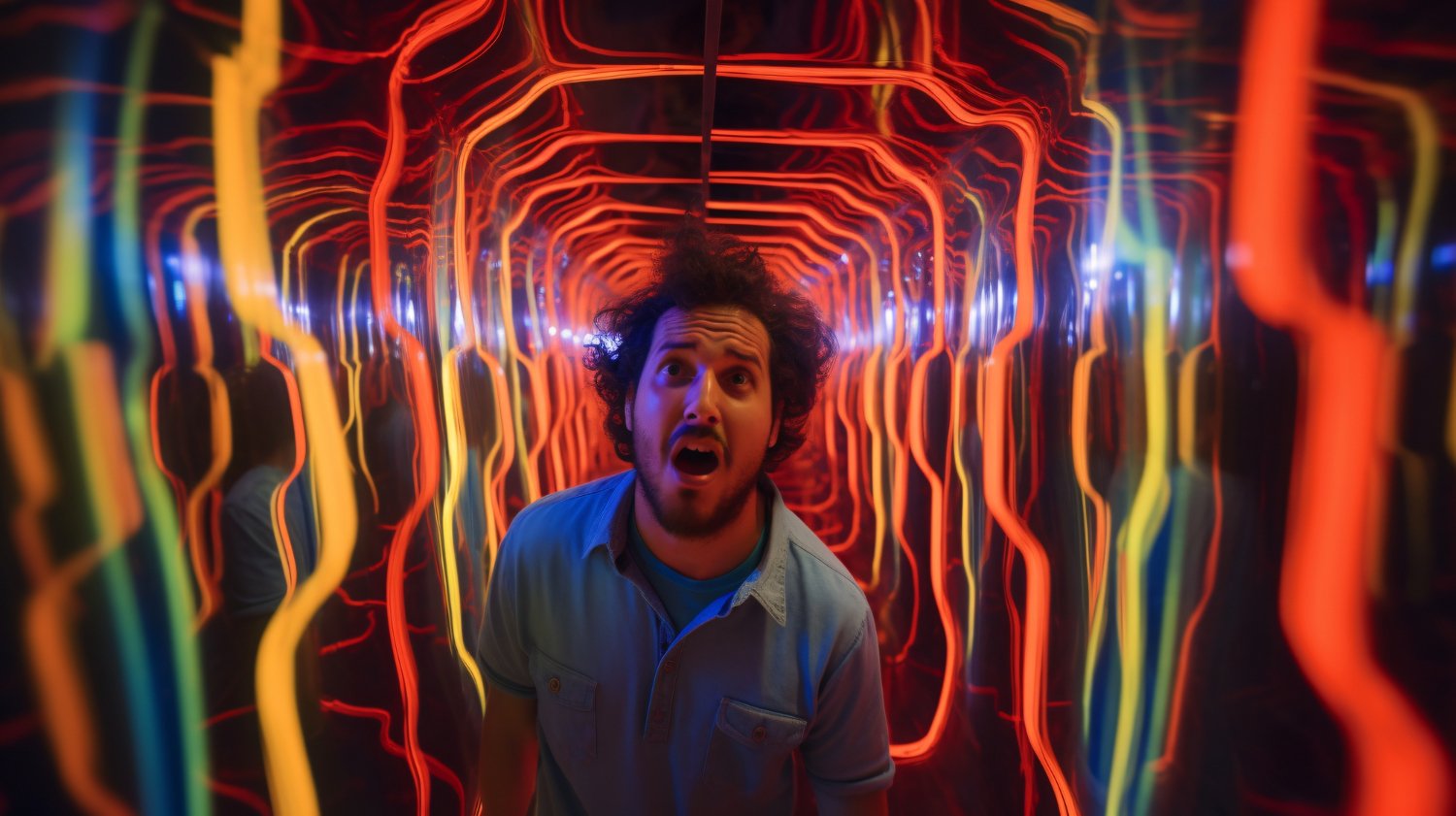What are hallucinations?
Hallucinations, the deceptive fabrications of sensory perception, encompass a spectrum of experiences ranging from visual phantasms to auditory echoes, tactile sensations, olfactory scents, and even gustatory illusions. These perceptual distortions find their genesis in an array of conditions spanning mental illnesses like schizophrenia and neurological afflictions such as Parkinson’s disease, epilepsy, migraines, Alzheimer’s, and dementia.
These hallucinatory episodes, triggered by a labyrinth of factors including substance use, delirium, or dementia, and exacerbated by fever, narcolepsy, or sensory impairments, weave through the corridors of the mind, often leaving individuals bewildered and disoriented.
Urgent medical intervention is necessary to unravel the enigma, identify the root cause, and pave the path towards tailored interventions for resolution when hallucinations emerge, whether triggered by sleep deprivation, medication regimes, or the tumult of severe illnesses like organ failure or brain malignancies.
Importance of Understanding Hallucinations
Understanding hallucinations is essential for several reasons. Firstly, they can indicate an underlying medical or psychiatric condition that requires attention and treatment. Secondly, hallucinations can cause distress and interfere with daily functioning, affecting an individual’s quality of life. By recognizing and addressing hallucinations early on, individuals can receive appropriate care to manage their symptoms and improve their overall well-being.
Types of Hallucinations
- Visual hallucinations: These involve seeing objects, people, or scenes that do not exist. Visual hallucinations can range from simple shapes or colors to detailed images of people or landscapes.
- Auditory Hallucinations: Auditory hallucinations involve hearing sounds or voices when no external auditory stimulus is present. These voices can be perceived as coming from inside or outside the individual’s head and may be benign or distressing in nature.
- Tactile Hallucinations: Tactile hallucinations involve feeling sensations on the skin or within the body that are not actually occurring. Examples include the sensation of insects crawling on the skin or a feeling of tingling or pressure.
- Olfactory Hallucinations: Olfactory hallucinations involve perceiving smells that are not present in the environment. These can range from pleasant scents to foul odors and may be associated with certain memories or emotions.
- Gustatory Hallucinations: Gustatory hallucinations involve experiencing tastes in the absence of any corresponding flavors. These hallucinations can be sweet, sour, bitter, or salty and may occur spontaneously or in response to specific stimuli.
Hallucinations in the elderly

Hallucinations among the elderly pose a multifaceted challenge, often intertwined with diverse underlying conditions. One prevalent culprit is Charles Bonnet syndrome, marked by visual hallucinations prevalent in individuals grappling with declining vision, particularly in advanced age. These visual distortions may manifest as either simplistic phenomena, such as fleeting flashes of light, or intricate scenarios involving vivid depictions of animals or people. Crucially, healthcare providers must possess astute awareness of this syndrome to distinguish it from other potential etiologies like delirium, dementia, or drug-induced states. Visual hallucinations in older adults may also signify an array of conditions, including dementia, Parkinson’s disease, seizures, recreational substance misuse, and various medical ailments.1
When addressing hallucinatory experiences in elderly individuals, fostering a supportive milieu is paramount. Engaging with empathy and refraining from challenging the perceptions of those experiencing hallucinations, especially within the context of dementia, acknowledges their reality despite its deviation from objective truth. Treatment strategies should primarily target the underlying cause; for instance, optimizing environmental lighting may mitigate symptoms stemming from Charles Bonnet syndrome. Moreover, vigilance toward factors such as hydration status, medication side effects, cognitive decline, and bereavement can further inform tailored interventions to alleviate hallucinatory episodes and enhance the overall well-being of elderly individuals.
Read Also: Depression: Breaking Down the Walls of Silence
Causes of Hallucinations
Those enigmatic distortions of reality can emerge from a plethora of underlying conditions, each casting its own shadow upon the mind’s eye. Among the labyrinthine corridors of causation lie several notable contenders:2

1. Schizophrenia
A formidable adversary in the realm of mental health, schizophrenia often serves as a harbinger of hallucinatory experiences. Astonishingly, this condition ensnares more than 70% of individuals within the labyrinth of visual hallucinations, while an even more staggering 60% to 90% are haunted by the disembodied echoes of auditory hallucinations.
2. Parkinson’s Disease
The tremulous hands of Parkinson’s disease may extend their reach beyond the physical, manifesting in the ethereal realm of hallucinations. Indeed, up to half of those grappling with this neurological titan may find themselves gazing upon specters that exist only within the recesses of their own minds.
3. Alzheimer’s Disease and Dementia
Within the labyrinth of Alzheimer’s and dementia, where memories falter and identities fade, hallucinations may lurk as spectral manifestations of the mind’s decline. Of particular note is Lewy body dementia, whose sinister tendrils weave through the brain’s architecture, casting shadows that birth visions where none should exist.
4. Migraines
Amidst the storm of neural chaos that accompanies a migraine, a peculiar phenomenon known as “aura” may emerge. Within this tempest, visual hallucinations dance and flicker, painting vivid tapestries upon the canvas of the sufferer’s consciousness. Astonishingly, around a third of those who grapple with migraines find themselves ensnared within this phantasmagoric dance.
5. Other Causes
The etiological tapestry of hallucinations is as diverse as it is complex. From the electrical storms of epilepsy to the sinister whispers of brain tumors, from the macabre visions of Charles Bonnet syndrome to the labyrinthine depths of substance use disorders, hallucinations can arise from a multitude of origins. Even the capricious winds of depression and bipolar disorder may stir the embers of hallucinatory experience, weaving shadows where none should be.
In their myriad forms, false perceptions of sensory experiences are capable of ensnaring the unwary mind in their web of deceit. While often heralded as harbingers of psychosis-related disorders such as schizophrenia, they can also emerge from the murky depths of substance use, the neurological maelstroms of epilepsy, or the transient disturbances of temporary conditions.
Crucially, when confronted with the specter of hallucinations, seeking medical attention becomes an imperative. Only through the discerning gaze of healthcare professionals can the labyrinthine maze of causation be navigated, leading to the elucidation of underlying causes and the formulation of appropriate treatment strategies. Thus, in the face of hallucinatory incursions, let not the veil of uncertainty shroud one’s resolve; instead, let it serve as a beacon, guiding the afflicted towards the shores of understanding and healing.
When to Seek Help
It’s essential to recognize when hallucinations warrant professional intervention. Warning signs include:
- Difficulty discerning reality from hallucinations.
- If it causes distress or poses a danger to oneself or others,.
- Hallucinations are accompanied by other concerning symptoms like mood swings, confusion, or cognitive impairment.
The Imperative of Seeking Help
In the labyrinthine landscape of hallucinations, seeking assistance becomes paramount, both for the afflicted individual and those in their orbit. Especially when detachment from reality or the presence of psychotic symptoms threatens to ensnare the mind, prompt intervention is crucial. Recognizing the gravity of these experiences and acknowledging the need for professional guidance can pave the way toward effective management and resolution.
Navigating the Path to Treatment
When confronted with the enigmatic realm of hallucinations, the journey toward healing begins with the pivotal step of seeking professional guidance. Healthcare providers, armed with their expertise and diagnostic acumen, stand as beacons of hope amidst the uncertainty. Treatment modalities, tailored to the underlying cause, may encompass a spectrum of interventions, ranging from therapy and medication for mental health conditions like schizophrenia to targeted approaches addressing neurological or physiological factors.
The Importance of Open Communication and Vigilance
In the intricate dance of managing hallucinations, open communication serves as a linchpin, binding together the threads of understanding and support. Every symptom, no matter how seemingly insignificant, deserves attention and discussion with healthcare professionals. For in the silent whispers of neglected concerns lie the seeds of potential distress and danger, which may flourish unchecked if left unaddressed.
Medical Treatment of Hallucinations
Hallucinations, particularly in schizophrenia spectrum disorders, can be effectively managed through various treatment approaches. These include:3

1. Medication: Antipsychotic drugs like olanzapine, amisulpride, ziprasidone, and quetiapine are commonly used to reduce the frequency and severity of hallucinations in schizophrenia. Haloperidol is also effective but may be slightly inferior.
2. Psychotherapy: Cognitive-behavioral therapy (CBT) has shown promise in reducing emotional distress associated with auditory hallucinations and developing new coping strategies.
3. Transcranial Magnetic Stimulation (TMS): TMS is considered a potentially useful treatment method for auditory hallucinations when combined with antipsychotic treatment.
4. Electroconvulsive Therapy (ECT): ECT is reserved as a last resort for treatment-resistant psychosis in schizophrenia. While it has shown overall symptom improvement, a specific reduction in hallucination severity has not been consistently demonstrated.
5. Other Medications: In cases where antipsychotics are not fully effective, medications like antiepileptics and cholinesterase inhibitors have been reported to be beneficial.
It’s crucial for healthcare providers to tailor treatment plans based on individual needs and responses to different interventions. Regular monitoring and adjustments may be necessary to ensure optimal management of hallucinations in various disorders.
Conclusion
Hallucinations are complex phenomena that can arise from various underlying conditions. Understanding the different types and causes of hallucinations is essential for recognizing when to seek help. Early diagnosis and intervention are key to managing underlying conditions and improving overall well-being.
Additional Points
It’s important to differentiate between hallucinations and illusions. While hallucinations involve perceiving stimuli that aren’t there, illusions are misinterpretations of real stimuli.
For further information and support, individuals can reach out to mental health organizations, support groups, or healthcare professionals specializing in psychiatric care. However, it’s essential to remember that this blog is not a substitute for medical advice. We encourage readers to consult with a healthcare professional if they have concerns about their mental health or experiences with hallucinations.
